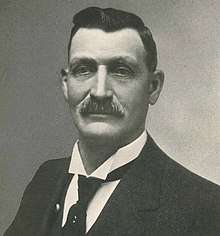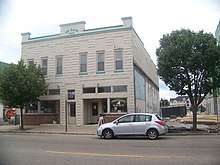William Rath
William Albert L. Rath (January 28, 1849 – August 10, 1916) was a German-American businessman known for developing Mason County and Ludington, Michigan. He was a lumber baron, business magnate and philanthropist. He was a leader in raising funds for local and charitable causes. Rath was a long-term city council member and was Mayor of Ludington for one term..
William Rath | |
|---|---|
 1912 | |
| Born | January 28, 1849 Hamburg, Germany |
| Died | August 10, 1916 (aged 67) |
| Resting place | Cartier Memorial Park, a/k/a Lakeview Cemetery Ludington, Michigan, US |
| Nationality | German |
| Education | German public schools |
| Occupation | businessman, lumberman |
| Known for | developing Mason County and Ludington, Michigan |
| Title | General Manager, Mayor, Banker, Manufacturer |
| Spouse(s) | Lucy Rickhoff |
| Children | 3 |
| Signature | |
Early life and education
William Rath was born in Hamburg, Germany on January 28, 1849. His father, Hans Rath, lived his entire life in Germany. His mother, Mary Rath, died at William's home in Ludington, Michigan, after living in America for twenty years.[1][2]
Rath attended public schools in Hamburg for his initial education.[1] He served as an apprentice locksmith, but did not complete his apprenticeship. Rath then assisted his father as a mason.[3] Rath grew up in Hamburg, then emigrated to America at the age of 21. He entered New York City, and then made his way to Michigan, arriving in Ludington on June 21, 1870.[1][4]
Business career
Rath's first jobs were as a laborer in Ludington sawmills. Eventually, he was promoted to lumber inspector, gaining him other responsibilities. His success in the lumber industry made him a lumber baron.[5] Rath was the mayor of Ludington for a while. He was also a collector of customs for the port.[2][6] Rath was the president of the Ludington Board of Trade and regularly reported on the freighter traffic in the harbor.[7]
Rath became a part of the firm Weimer & Rath in 1880. Later he developed a partnership with Ludington businessman Warren Antoine Cartier. The two formed the lumber business of Rath & Cartier.[1] Rath founded the Ludington State Bank in 1901 with Charles G. Wing.[4][6] They also founded another bank in Mason County called Fountain Bank.[1][6]
Rath had extensive real estate in Mason and Manistee counties. He also owned property in Chicago. Through these real estate holdings he became a wealthy man.[8] Around 1890, he suffered a large financial loss after falling victim to a fraudulent copper mining investment scam perpetrated by Mr. Goldsborough. [3][9] Rath owned property, including a cottage in south beach Epworth.[10] His estate was the subject of two lawsuits.[11][12]
Rath was involved with the following businesses:
Memberships and affiliations
Rath was a member of the Ludington Board of Trade from its beginning. For two years, he was its president. He was the deputy collector of customs in Ludington for over a decade. Rath belonged to the Mason county board of supervisors (Board of Aldermen) for ten years.[4] Rath was the mayor of Ludington from 1910 to 1911.[8][15]
Personal life
Rath married Miss Lucy Rickhoff, who was also of German descent, on July 17, 1870. They had one child, Jennie. They also had two adopted daughters named Ella and Jessie.[8] Rath and his wife were devout members of the local German Lutheran church, St. John's Lutheran.[3][8] Rath was a supporter of the Republican Party.[8] Rath died from a heart attack on August 10, 1916.[3] His remains are interred at Lakeview Cemetery in Ludington.[16][upper-alpha 1]

Legacy
When memories of the town's founder, James Ludington, faded, Charles Street was renamed Rath Avenue for William Rath.[upper-alpha 2] The William Rath Building, which was 100 blocks south of Ludington Avenue, was presented to the Salvation Army. The building served as the Salvation Army's headquarters from 1936 to 1961.[20] Rath and Antoine E. Cartier bought the Cartier Park land near Lincoln Lake. He bequeathed $25,000 for its improvement and gifted it to the city.[upper-alpha 3] Rath is memorialized in a mural showing him drinking from a Fountain of Youth, a stylish trend in the late 1800s.[6] The mural is located at 106 N. Rath Ave; it was painted by Ludington artist Therese Soles.[6]
References
Notes
- Rath's name appears on the gateway to the Cartier Memorial Cemetery, now known as Lakeview Cemetery, in Ludington.[17]
- Amelia, Charles, Emily, Gaylord, and Lewis are north south streets in Ludington, named for James Ludington's family members (his "children" in one source). East-west streets were named for Ludington's cronies: Filer, Foster and Melendy.[18][19]
- Adjacent to Lincoln Lake, now including a camp ground, with hiking and biking trails.[6][8][21]
Citations
- Powers & Cutler 1912, p. 778.
- Cabot 2005, pp. 42 –43.
- "William Rath, Public Spirited Citizen, is Called to the Beyond". Ludington Daily News. Ludington, Michigan. August 11, 1916.
- "William Rath". Mason County History Companion. Retrieved September 12, 2019.
- "Lumbering". Michigan history. Michigan State University. Retrieved September 21, 2019.
- "The Colorful Murals of Ludington". West Michigan Business Directories. Advantage Marketing & Publications, Inc. March 16, 2019. Archived from the original on September 14, 2019. Retrieved September 12, 2019.
He is shown drinking from a "Fountain of Youth," something that was in vogue in the late 1800s
- Ludington Daily News Editor 1997, p. 11.
- Powers & Cutler 1912, p. 779.
- Cabot 2005, p. 68.
- Cabot 2005, p. 104.
- Supreme Court of Michigan (January 31, 1936). "Ludington Bank v Estate of Rath". Retrieved September 13, 2019.Supreme Court of Michigan (1936). Ludington Bank v Estate of Rath. NW. 264. Eagan, Minnesota: West Publishing Company. p. 866. Retrieved September 13, 2019.
- Supreme Court of Arkansas (1924). Opinion. SW. 266. Eagan, Minnesota: West Publishing Company. p. 304. Retrieved September 13, 2019.
- Cartier & Hawley 1957, p. 5.
- Cabot 2005, p. 43.
- "Mayors and Postmasters of Ludington, Michigan". The Political Graveyard. Retrieved September 21, 2019.
- "Burial Records" (PDF). City of Ludington, Michigan (Lakeview Cemetery). January 21, 2015. Retrieved September 22, 2019.
- "Cartier Park Memorial cemetery" (Photograph). Retrieved September 15, 2019. "Rath Crypt" (Photograph). Retrieved September 22, 2019. William Albert L. Rath at Find a Grave
- Mason County History Society 1980, p. 11
- Lewis-Malburg 2019, p. 11.
- "The Salvation Army, Ludington Corps". Ludington Chamber of Commerce. Archived from the original on November 14, 2015. Retrieved September 12, 2019.
- "Cartier Park". Get off the couch. Archived from the original on March 5, 2019. Retrieved September 15, 2019.
Bibliography
- Cabot, James L. (October 12, 2005). Ludington: 1830–1930 (Paperback). Images of America. Charleston, South Carolina: Arcadia Publishing. ISBN 9780738539515.CS1 maint: ref=harv (link)
- Cartier, Morgan E.; Hawley, Rose D. (December 7, 1957). "Cartier Family". Ludington Daily News (5). p. 5. Retrieved September 21, 2019.CS1 maint: ref=harv (link)
- Lewis-Malburg, Sandi (May 13, 2019). Lost Towns of Mason County, MI (Paperback). Lost. Charleston, South Carolina: Arcadia Publishing. p. 11. ISBN 9781467142656.CS1 maint: ref=harv (link)
- Ludington Daily News Editor (January 1, 1997). Ludington's carferries (First ed.). Ludington Daily News. p. 11. ASIN B000FKPTF6.CS1 maint: ref=harv (link)
- Mason County History Society (1980). Historic Mason County, MI, 1980. Ludington, Michigan: Mason County History Society. OCLC 7429821.CS1 maint: ref=harv (link)
- Powers, Perry Francis; Cutler, Harry Gardner (1912). History of Northern Michigan. 2. Chicago: The Lewis Publishing Company.CS1 maint: ref=harv (link)